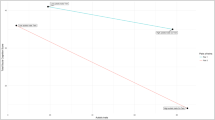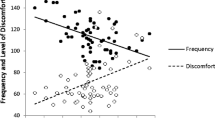Abstract
The finding that relatives of individuals with autism show mild autistic traits is referred to as the broader autism phenotype (BAP). In the current study, 25 parents with a child with high-functioning autism and 25 parents with typically developed children were compared on: (1) the Block Design Test, (2) the Autism-Spectrum Quotient (AQ), and (3) a reaction time task to examine reflexive covert visual orienting to social (eyes) and non-social (arrows) cues. The parent groups were scored similar on the Block Design Test and the AQ. However, fathers with an autistic child demonstrated a different reaction time pattern and responded slower on the social cues than control fathers. These results partly support and further elaborate on the BAP in parents with an autistic child.







Similar content being viewed by others
References
American Psychological Association. (1994). Diagnostic and statistical manual of mental disorders (4th ed.). Washington DC: American Psychiatric Association.
Austin, E. J. (2005). Personality correlates of the broader autism phenotype as assessed by the Autism Spectrum Quotient (AQ). Personality and Individual Differences, 38, 451–460.
Bailey, A., Palferman, S., Heavey, L., & Le Couteur, A. (1998). Autism: The phenotype in relatives. Journal of Autism and Developmental Disorders, 28, 369–392.
Baron-Cohen, S. (1995). Mindblindedness: An essay on autism and theory of mind. Cambridge, MA: MIT.
Baron-Cohen, S., Wheelwright, S., Skinner, R., Martin, J., & Clubley, E. (2001). The Autism-Spectrum Quotient (AQ): Evidence from Asperger syndrome/high-functioning autism, males and females, scientists and mathematicians. Journal of Autism and Developmental Disorders, 31, 5–17.
Bates, T., & Stough, C. (1997). Processing speed, attention, and intelligence: effects of spatial attention on decision time in high and low IQ subjects. Personality and Individual Differences, 23, 861–866.
Beringer, J. (1996). Experimental Run Tim System (ERTS), Version 3.18. Frankfurt: Berisoft.
Bolton, P. F., Pickles, A., Murphy, M., & Rutter, M. (1998). Autism, affective and other psychiatric disorders: patterns of familial aggregation. Psychological Medicine, 28, 385–395.
Briskman, J., Happé, F., & Frith, U. (2001). Exploring the cognitive phenotype of autism: Weak “central coherence” in parents and siblings of children with autism: II. Real-life skills and preferences. Journal of Child Psychology and Psychiatry, 42, 309–316.
Chawarska, K., Klin, A., & Volkmar, F. (2003). Automatic attention cueing through eye movement in 2-year-old children with autism. Child Development, 74, 1108–1122.
Dawson, G., Meltzoff, A. N., Osterling, J., Rinaldi, J., & Brown, E. (1998). Children with autism fail to orient to naturally occurring social stimuli. Journal of Autism and Developmental Disorders, 28, 479–485.
Deary, I. J., Der, G., & Ford, G. (2001). Reaction times and intelligence differences A population-based cohort study. Intelligence, 29, 389–399.
Fombonne, E., Bolton, P., Prior, J., Jordan, H., & Rutter, M. (1997). A family study of autism: cognitive patterns and levels in parents and siblings. Journal of Child Psychology and Psychiatry, 38, 667–683.
Happé, F. (1999). Autism: cognitive deficit or cognitive style?. Trends in Cognitive Science, 3, 216–222.
Happé, F., Briskman, J., & Frith, U. (2001). Exploring the cognitive phenotype of autism: Weak “central coherence” in parents and siblings of children with autism: I. Experimental tests. Journal of Child Psychology and Psychiatry, 42, 299–307.
Harris, N. S., Courchesne, E., Townsend, J., Carper, R. A., & Lord, C. (1999). Neuroanatomic contributions to slowed orienting of attention in children with autism. Cognitive Brain Research, 8, 61–71.
Hughes, C., Leboyer, M., & Bouvard, M. (1997). Executive function in parents of children with autism. Psychological Medicine, 27, 209–220.
Jarrold, C., Butler, D. W., Cottington, E. M., & Jimenez, F. (2000). Linking theory of mind and central coherence bias in autism and in the general population. Developmental Psychology, 36, 126–138.
Jolliffe, T., & Baron-Cohen, S. (1997). Are people with autism and Asperger syndrome faster than normal on the Embedded Figures Test?. Journal of Child Psychology and Psychiatry, 38, 527–534.
Klin, A., Jones, W., Schultz, R., Volkmar, F., & Cohen, D. (2002). Visual fixation patterns during viewing of naturalistic social situations as predictors of social competence in individuals with autism. Archives of General Psychiatry, 59, 809–816.
Kylliänen, A., & Hietanen, J. K. (2004). Attention orienting by another’s gaze direction in children with autism. Journal of Child Psychology and Psychiatry, 45, 435–444.
Landa, R., Piven, J., Wzorek, M. M., Gayle, J. O., Chase, G. A., & Folstein, S. E. (1992). Social language use in parents of autistic individuals. Psychological Medicine, 22, 245–254.
Landry, R, & Bryson, S. E. (2004). Impaired disengagement of attention in young children with autism. Journal of Child Psychology and Psychiatry, 46, 1115–1122.
Leboyer, M., Plumet, M-H., Goldblum, M-C., Perez-Diaz, F., & Marchaland, C. (1995). Verbal versus visuospatial abilities in relatives of autistic females. Developmental Neuropsychology, 11, 139–155.
Leekham, S. R., Hunnisett, E., & Moore, C. (1998). Targets and cues: Gaze-following in children with autism. Journal of Child Psychology and Psychiatry, 39, 951–962.
Morgan, B., Mayberry, M., & Durkin, K. (2003). Weak central coherence, poor joint attention, and low verbal ability: independent deficits in early autism. Developmental Psychology, 39, 646–656.
Osterling, J., & Dawson, G. (1994). Early recognition of 1-year-old infants with autism spectrum disorder versus mental retardation: A study of first birthday home videotapes. Journal of Autism and Developmental Disorders, 24, 247–257.
Pickles, A., Bolton, P., MacDonald, H., Bailey, A., Le Couteur, A., Sim, C. -H., Rutter, M. (1995). Latent-class analysis of recurrence risks for complex phenotypes with selection and measurement error: a twin and family history study of autism. American Journal of Human Genetics, 57, 717–726.
Piven, J., & Palmer, P. (1997). Cognitive deficits in parents from multiple-incidence autism families. Journal of Child Psychology and Psychiatry, 38, 1011–1021.
Piven, J., Palmer, P., Landa, R., Santangelo, S., Jacobi, D., & Childress, D. (1997). Personality and language characteristics in parents from multiple-incidence autism families. American Journal of Medical Genetics, 74, 398–411.
Piven, J., Wzorek, M., Landa, R., Lainhart, J., Bolton, P., Chase, G. A., & Folstein, S. (1994). Personality characteristics of the parents of autistic individuals. Psychological Medicine, 24, 783–795.
Plumet, M-H., Goldblum, M-C., & Leboyer, M. (1995). Verbal skills in relatives of autistic females. Cortex, 31, 723–733.
Posner, M. I., Walker, J. A., Friedrich, F. J., & Rafal, R. D. (1984). Effects of parietal injury on covert orienting of attention. Journal of neuroscience, 4, 1863–1974.
Rincover, A., & Ducharme, J. M. (1986). Variables influencing stimulus overselectivity and ‘tunnel vision’ in developmentally delayed children. American Journal of Mental Deficiency, 91, 422–430.
Santangelo, S. L., & Folstein, S. E. (1995). Social deficits in the families of autistic probands. American Journal of Human Genetics, 57, 89.
Senju, A., Tojo, Y., Dairoku, H., & Hasegawa, T. (2004). Reflexive orienting in response to eye gaze and an arrow in children with and without autism. Journal of Child Psychology and Psychiatry, 45, 445–458.
Shah, A., & Frith, U. (1993). Why do autistic individuals show superior performance on the block design test? Journal of Child Psychology and Psychiatry, 34, 1351–1364.
Szatmari, P., Jones, M. B., Tuff, L., Bartolucci, G., Fisman, S., & Mahoney, W. (1993). Lack of cognitive impairment in first-degree relatives of children with pervasive development disorders. Journal of the American Academy of Child and Adolescent Psychiatry, 32, 1264–1273.
Van Lang, N. D. J., Bouma, A., Sytema, S., Kraijer, D. W., & Minderaa, R. B. (2006). A comparison of central coherence skills between adolescents with an intellectual disability with and without comorbid autism spectrum disorder. Research in Developmental Disabilities, 27, 217–226.
Vlamings, P. H. J. M., Stauder, J. E. A., van Son, I. A. M., & Mottron, L. (2005). Atypical visual orienting to gaze- and arrow-cues in adults with high functioning autism. Journal of Autism and Developmental Disorders, 35, 267–277.
Wainwright-Sharp, J. A., & Bryson, S. E. (1993). Visual orienting deficits in high-functioning people with autism. Journal of Autism and Developmental Disorders, 23, 1–13.
Wechsler, D. (2004). Afname en scoringshandleiding voor de Wechsler Adult Intelligence Scale—Derde Editie. Amsterdam: Harcourt Test Publishers.
Willemsen-Swinkels, S. H. N., Buitelaar, J. K., Weijnen, F. G., & Van Engeland, H. (1998). Timing of social gaze behavior in children with a pervasive developmental disorder. Journal of Autism and Developmental Disorders, 28, 199–210.
Wolff, S., Narayan, S., & Moyes, B. (1988). Personality characteristics of parents of autistic children. Journal of Child Psychology and Psychiatry, 29, 143–154.
Yirmiya, N., Pilowsky, T., Solomonica-Levi, D., & Shulman, C. (1999). Brief report: Gaze behavior and theory of mind abilities in individuals with autism, Down syndrome, and mental retardation of unknown etiology. Journal of Autism and Developmental Disorders, 29, 333–341.
Zwaigenbaum, L., Bryson, S., Rogers, T., Roberts, W., Brian, J., & Szatmari, P. (2005). Behavioral manifestations of autism in the first year of life. International Journal of Developmental Neuroscience, 23, 143–152.
Acknowledgments
We would like to thank all parents who participated in this study. Special thanks to those families who helped us recruit parents for the control group. Furthermore, we would like to thank Marijke Zelissen from the IvOO and Martine Strous from Sint Oda for their kind cooperation.
Author information
Authors and Affiliations
Corresponding author
Rights and permissions
About this article
Cite this article
Scheeren, A.M., Stauder, J.E.A. Broader Autism Phenotype in Parents of Autistic Children: Reality or Myth?. J Autism Dev Disord 38, 276–287 (2008). https://doi.org/10.1007/s10803-007-0389-x
Received:
Accepted:
Published:
Issue Date:
DOI: https://doi.org/10.1007/s10803-007-0389-x




